Spinach Ricotta Ravioli
My Spinach Ricotta Ravioli is a classic Italian dish that your whole family will love!
These delicate Italian ravioli are filled with rich, creamy ricotta, spinach, savory Parmigiano Reggiano cheese and a touch of nutmeg. To finish, my homemade ravioli are tossed in a simple butter sauce and extra cheese to serve. It’s heaven on a plate!
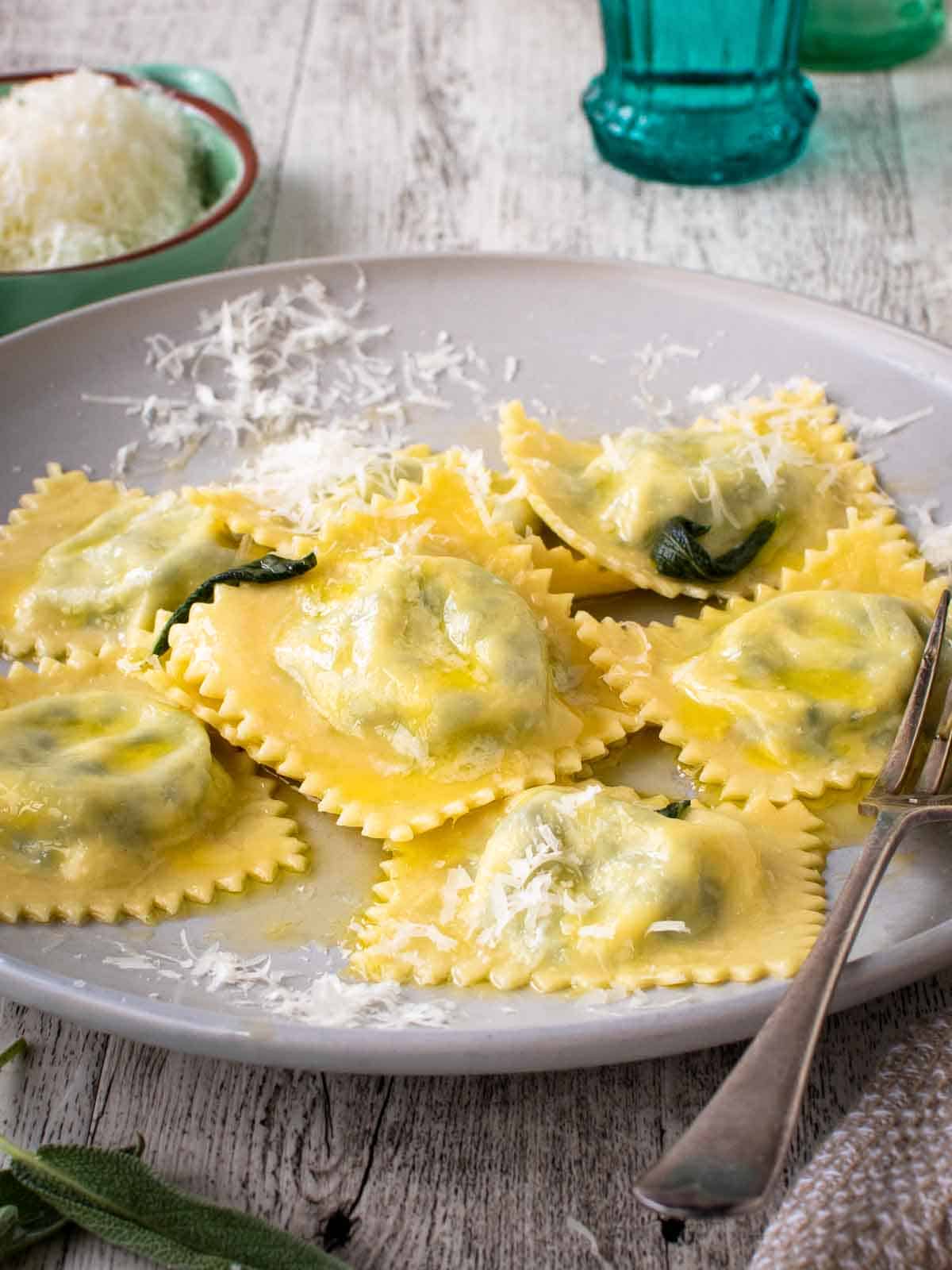
If you’ve always wanted to make homemade ravioli but thought it was too difficult, this is the recipe for you! I’ve included a comprehensive step by step process and lots of helpful hints to make the perfect Spinach Ricotta Ravioli. While this is a more complicated recipe, it’s not out of the reach of most home cooks.
This recipe is based on my family’s recipe for tortelli d’erbetta which is a classic filled pasta from my dad’s region of Emilia Romagna. It produces luscious and delicate ricotta ravioli with spinach that is sure to impress your friends and family. The spinach ricotta cheese filling is so velvety and loaded with flavor from the Parmigiano Reggiano cheese and freshly grated nutmeg.
My Spinach Ricotta Ravioli recipe is the perfect dish to celebrate special occasions and important milestones with your loved ones. In fact, this was the dish that marked all the memorable events in my childhood. I know that once you’ve made these homemade ravioli and created the same family memories, you’ll never use the store bought version again.
Why you’ll love this recipe
- Taste – these Spinach Ricotta Ravioli are filled with a flavorsome and creamy ricotta cheese mix. The slightly bitter spinach perfectly sets off the rich, creaminess of the ricotta.
- Versatile – the sauce to serve these Spinach Ricotta Ravioli is made simply with butter and Parmesan cheese but if your family loves tomato sauce that will work too. So will a basic olive oil, garlic and chilli sauce.
- Nutritious – spinach is rich in iron, vitamins and minerals and pairs perfectly with ricotta which is high in calcium and a great source of other nutrients.
- No fancy equipment – this recipe doesn’t require any fancy ravioli makers, just your trusty pasta machine and basic kitchen equipment.
- Step by step – This recipe will give you step by step instructions and all the tips needed to make these ricotta ravioli perfectly.
What is Ravioli?
Ravioli are Italian filled pasta that is usually square or circular in shape. The ingredients for fillings can vary from cheese, meat, vegetables, or a combination of any of these. Even mushrooms like in my homemade mushroom ravioli.
To make ravioli, pasta is rolled thinly and spoonfuls of the filling are placed in the middle. The pasta is folded over enclosing the filling and creating small stuffed pasta dumplings. Ravioli are usually boiled and then served with a sauce or in broth, all of which are very popular in Italy and around the world.
Depending on the region of Italy, filled pasta can go by many other names. Some of these names include tortellini (like my Tortellini alla Panna), Fagottini, cappelletti, agnolotti, mezzelune and culurgiones.
For complete ingredient quantities and full instructions, please scroll to the printable recipe card at the bottom of the page.
Ingredients
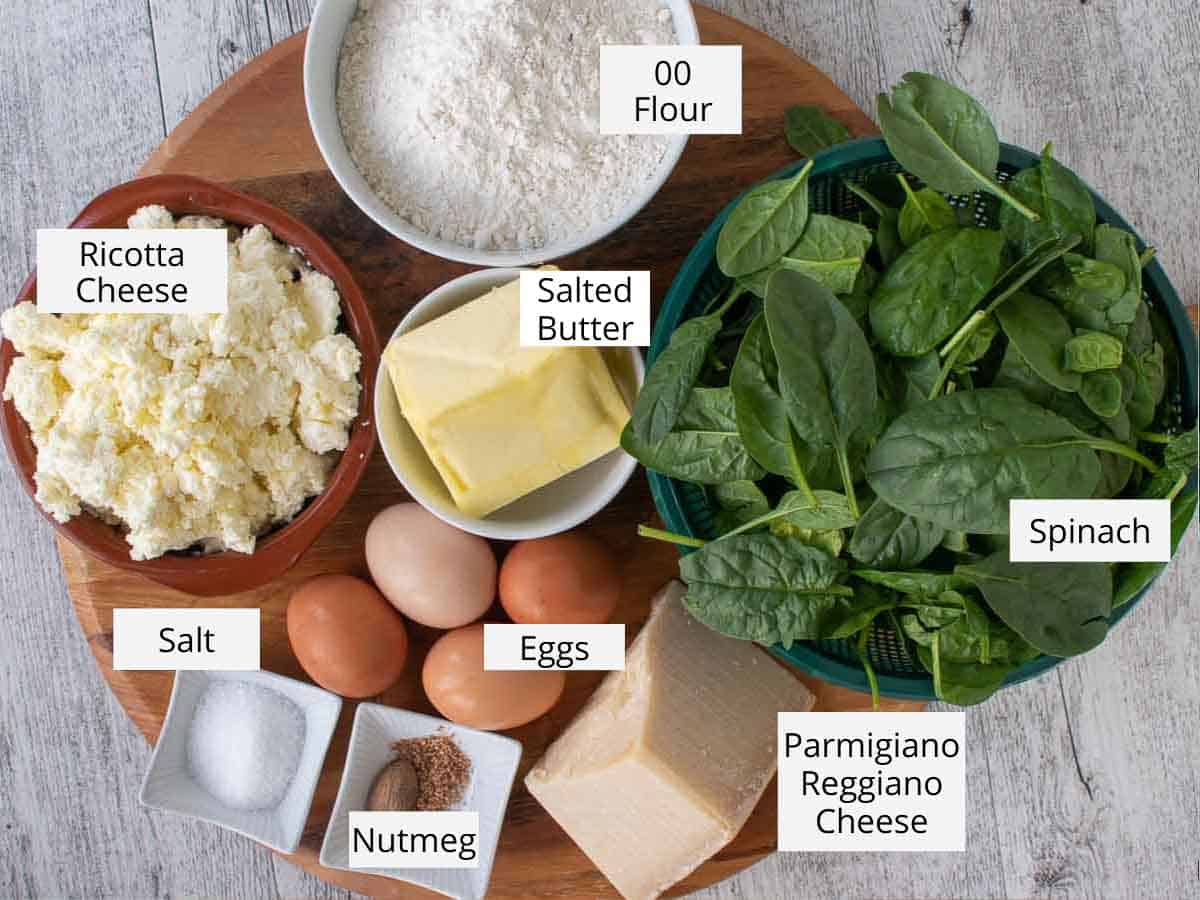
- Spinach – fresh spinach is my preference here.
- Ricotta cheese – Beautiful fresh ricotta cheese makes a beautiful creamy filling and can be purchased at most supermarkets. Depending on where you live in the world, ricotta cheese can be expensive to buy, so for a more economical option, you can use my recipe for homemade ricotta cheese.
- Parmigiano Reggiano cheese – also known as Parmesan Cheese. For best results, buy a block of cheese and grate it freshly as needed. This adds a lovely savory flavor to the ravioli filling and also for serving.
- Nutmeg – my preference is freshly grated nutmeg, but you could also use ground nutmeg.
- 00 Flour – also known as doppio zero flour. It is finely ground flour and the best choice of flour for making homemade pasta dough.
- Eggs – I prefer large free range eggs for this Spinach Ricotta Ravioli recipe.
- Semolina flour – this type of flour is made from coarsely ground durum wheat and is perfect for dusting and keeping the ravioli from sticking.
- Butter – unsalted butter for serving the Spinach Ricotta Ravioli.
See recipe card for quantities.
Instructions for Spinach Ricotta Filling
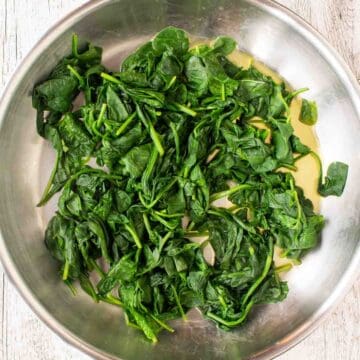
Wash spinach then cook in a pan over medium until wilted. Cool and squeeze out excess moisture. Chop spinach finely.
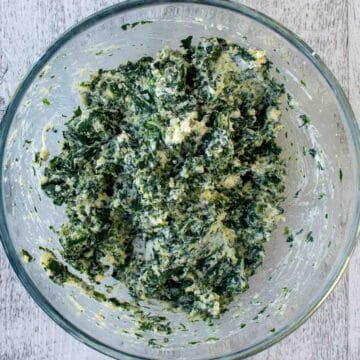
Combine chopped spinach with the remaining filling ingredients. Refrigerate until needed.
Hint: Don’t add any water to the pan to cook the spinach. The water clinging to the leaves after washing is enough.
Instructions for Pasta Dough
Reserve a couple of tablespoons of flour. Tip the remaining flour onto the work surface and make a well in the middle.
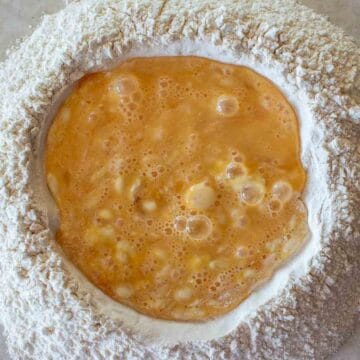
Break eggs into the well in the flour
Using a fork (or fingertips) whisk the eggs.
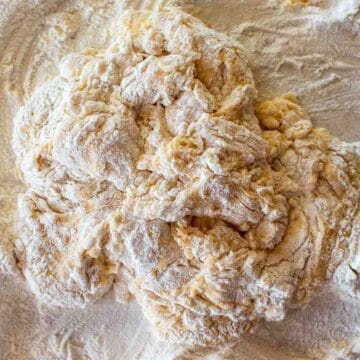
Gradually incorporate a little bit of flour into the eggs working into a scraggy dough.
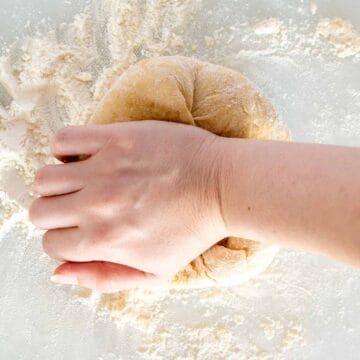
Knead the dough until it’s smooth.
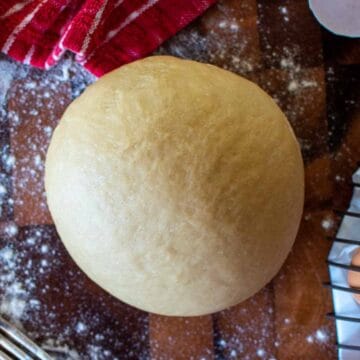
Form into a ball then cover with a bowl or wrap in plastic and set aside to rest.
Hint: For more step by step pasta dough instructions and photos, refer to my Tagliatelle Pasta recipe.
Instructions to make ravioli
Divide pasta dough into 4 equal parts. Take one portion and cover the remaining dough. Use either a hand cranked pasta machine or stand mixer pasta attachment and set the pasta machine rollers at the widest setting. Prepare large baking sheets lined with parchment paper that has been dusted with semolina flour.
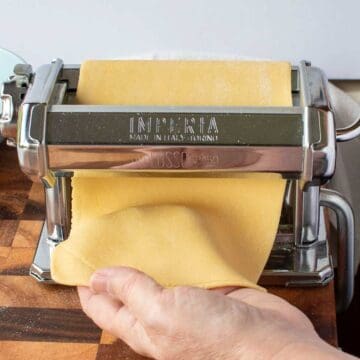
Pass the dough through the rollers. Fold and repeat until smooth. Reduce the roller width setting gradually, passing the dough through each time until 1/16 inch thick.
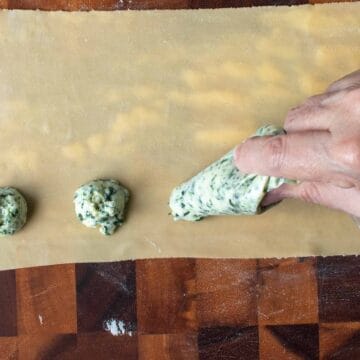
Place heaped teaspoons of filling (or use a piping bag) along the length half of the sheet, 1 inch apart. You should have 7-8 mounds.
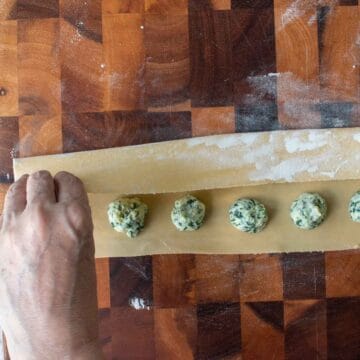
Fold the opposing long edge of pasta over the filling to cover. Press to seal.
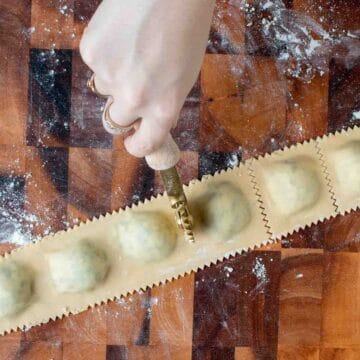
Cut into squares with a pastry wheel or a knife.
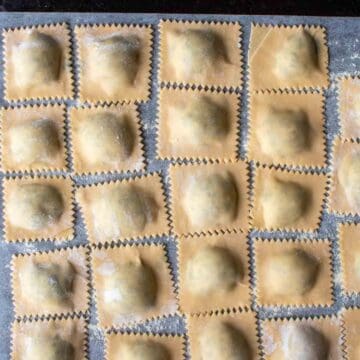
Arrange onto prepared baking sheets in a single layer. Repeat with the remaining dough and filling.
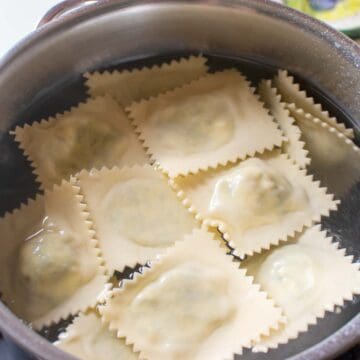
Cook the ravioli in lots of salted boiling water for 3 minutes. Drain then gently toss in butter sauce and Parmigiano Reggiano cheese.
Hint: Keep each mound of filling closer to the one long edge so that the other long edge can be folded over to seal. When pressing to seal, begin in the middle of the pasta sheet, and press around each mound expelling the air as you work your way towards each end.
Substitutions
- Spinach – substitute silverbeet, swiss chard or collard greens for the spinach in this ravioli filling. You can also use frozen spinach, however, you will need to thaw it and drain out the liquid so that it doesn’t make your Spinach Ricotta Ravioli soggy.
- Parmigiano Reggiano cheese – try pecorino romano instead. It will be saltier so be sure to adjust the seasoning.
- Nutmeg – if you don’t have nutmeg or don’t like the flavor, you can just leave it out.
Variations
- Zesty – try adding some lemon zest to the ravioli filling for a fresh and fragrant flavor.
- Garlicky – add some minced garlic into the Spinach Ricotta Ravioli filling for extra punch.
- Tomato sauce – serve these delicious homemade ravioli with my simple San Marzano Tomato Sauce.
Equipment
While you can roll out pasta dough with just a rolling pin but a hand cranked pasta machine or attachment for the stand mixer will make it easier to make these homemade ravioli. The pasta machine ensures the homemade pasta is rolled out thinly enough.
Don’t worry about buying fancy ravioli molds or ravioli makers. A fluted pastry pastry wheel will do the job just fine. You could even use a sharp knife if you don’t own a pastry wheel.
Storage
These ricotta spinach ravioli are best enjoyed fresh. Arrange the homemade ravioli on a sheet pan that is lined with parchment paper and dusted with semolina flour to prevent sticking. To avoid soft or soggy ravioli, cook them within an hour of shaping them or pop them in the refrigerator if it’s going to be longer.
You can freeze these Spinach Ricotta Ravioli for up to one month. I recommend freezing the homemade ravioli in an airtight container with layers of parchment paper in between the layers to stop them from sticking.
Top tips
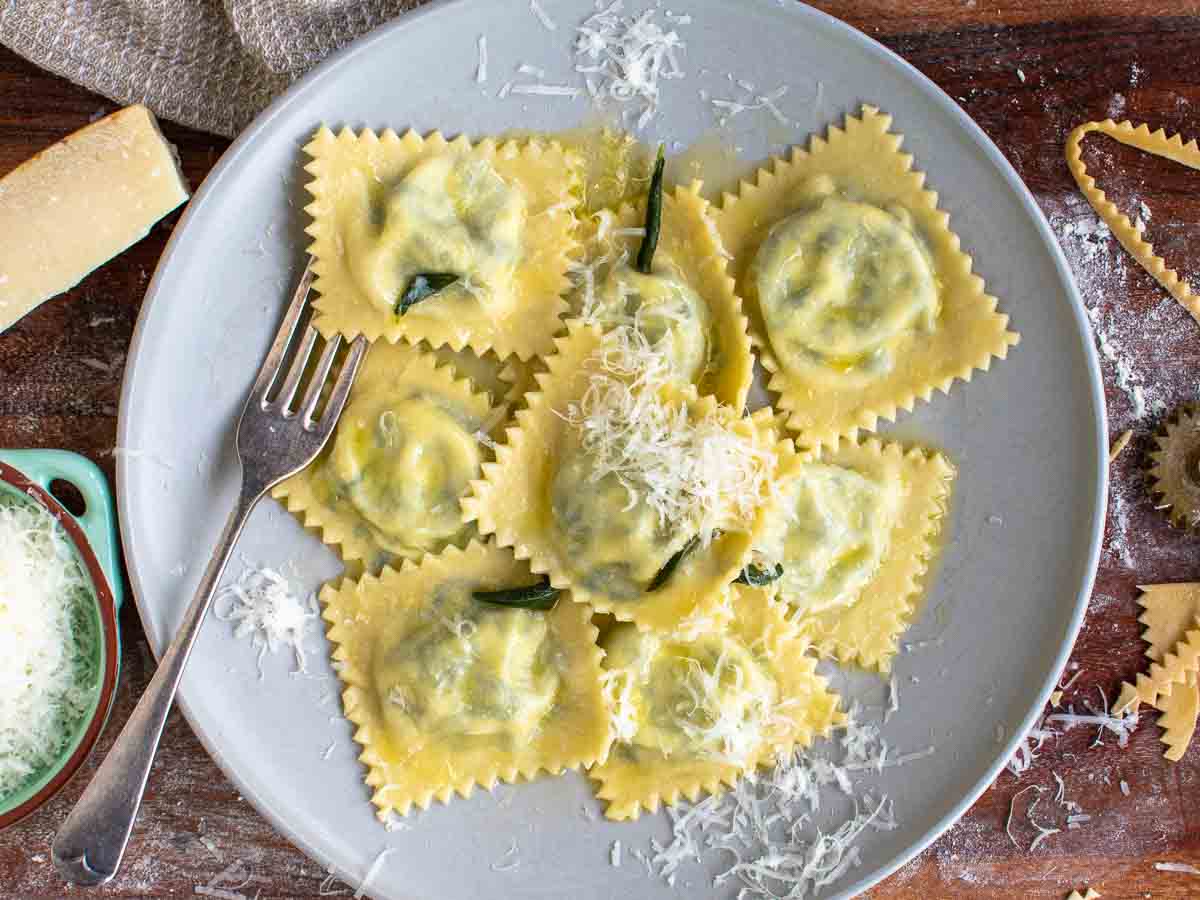
Preparation is the key to making homemade ravioli successfully! Declutter your workspace as you’ll need a large bench or table to shape the ricotta ravioli.
If you’re using store bought ricotta cheese, be sure to drain excess water from it. Don’t skip this step or the Spinach Ricotta filling will be too wet leaving you with soggy ravioli.
To make the perfect pasta dough and roll it out successfully, take a look at my Tagliatelle Pasta recipe for some helpful hints.
When shaping and assembling the ricotta ravioli be sure to gently smooth out the air bubbles using your fingers. Excess air trapped inside the sealed ravioli could cause the ravioli to open while they cook in the boiling water.
To avoid the Spinach Ricotta Ravioli from sticking, arrange on a baking sheet, lined with parchment paper and dusted with semolina flour. Ensure the ravioli do not touch or overlap as they will stick to each other.
FAQ
In Italian, ravioli refers to the small envelopes of pasta containing a filling. Ravioli is plural and raviolo is one singular Italian filled pasta.
I love to serve Spinach Ricotta Ravioli in a simple butter and Parmesan cheese sauce. However, you could also flavor the butter sauce with some fresh basil, fresh sage or minced garlic.
I’m not a believer in diet culture and like to eat everything in moderation. For this reason, Spinach Ricotta Ravioli are healthy! Ricotta is rich in calcium and protein. Spinach, like all dark leafy greens, is full of nutrients. And homemade fresh pasta or homemade ravioli are much healthier than store bought because they don’t include any preservatives.
Serving Suggestions
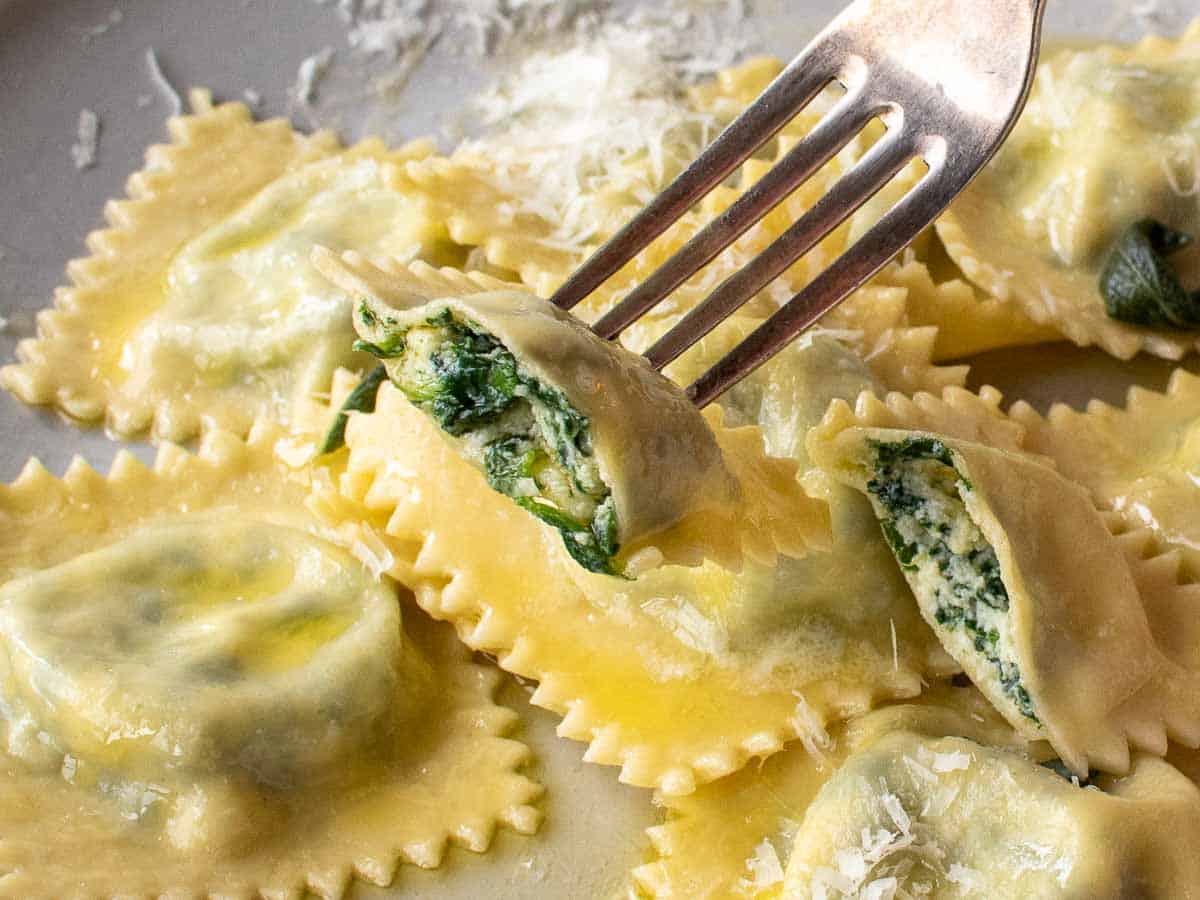
If you don’t like the simple butter ravioli sauce, you can serve these delicious Spinach Ricotta Ravioli in my San Marzano Tomato Sauce or a tomato cream sauce instead. Alongside this delicious pasta dish, you can serve my Semolina Bread for dunking into the sauce and my Mediterranean Cucumber Salad for some freshness.
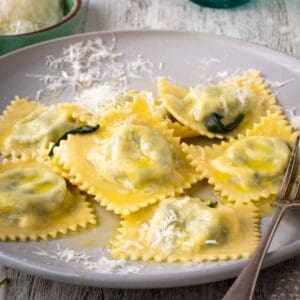
Spinach Ravioli Recipe with Ricotta
Equipment
- 1 Skillet
- 1 Hand cranked pasta machine
- 1 Fluted cutting roller optional
- 1 Large saucepan
- 1 Small saucepan
Ingredients
Spinach Ricotta Filling
- 8 ounces fresh spinach (226 grams)
- 1 pound fresh ricotta (450 grams)
- 4 ounces finely grated Parmigiano Reggiano (120 grams)
- 1 egg
- ¼ – ½ teaspoon ground nutmeg
- 1 teaspoon salt
Pasta Dough
- 3 ⅓ cups 00 flour (400 grams/14 ounces) See Note 1
- 4 eggs at room temperature
- Semolina flour for dusting
To Serve
- 4 ounces salted butter (115 grams)
- pinch salt
- 2 ounces finely grated Parmigiano Reggiano cheese extra to serve (60 grams)
Instructions
Spinach Ricotta Filling
- Wash the spinach and wilt in a skillet over medium heat. There’s no need to add any extra water.8 ounces fresh spinach
- Cool and squeeze out excess moisture.
- Chop spinach finely.
- Combine chopped spinach with the remaining filling ingredients.1 pound fresh ricotta4 ounces finely grated Parmigiano Reggiano1 egg¼ – ½ teaspoon ground nutmeg1 teaspoon salt
- Cover and refrigerate until ready to use.
Pasta Dough
- Important – Reserve a few tablespoons of flour to the side.3 ⅓ cups 00 flour
- Tip the remaining flour onto the work surface and make a well in the middle.
- Break eggs into the well in the flour4 eggs
- Using a fork (or fingertips) whisk the eggs like you’re making scrambled eggs. As you whisk, bring in a little bit of flour from around the edges and incorporate it into the eggs.
- Keep working more flour into the dough. A pastry scraper is useful or just use your hands.
- Add more flour as needed. The dough should not be sticky. If you are rolling by hand do not add too much flour.
- If the pasta dough is too sticky, knead in a little more flour. If the pasta dough is dry and hard to knead, knead in a little water teaspoon by teaspoon. The more pasta dough you make, the more you'll be able to judge by the feel of the dough.
- Knead the dough for 8-10 minutes or until it is smooth and you feel the change in the dough. Don’t omit this kneading.
- Put an upturned bowl over the dough or wrap in plastic wrap and allow to rest for 30 minutes or so.
Assemble the Ravioli
- Line large baking sheets with parchment paper then sprinkle with semolina flour. You may need 3 or 4 baking sheets.Semolina flour for dusting
- Divide pasta dough into 4 equal parts. Take one portion keeping the remaining dough covered.
- Use either a hand cranked pasta machine or pasta attachment for a stand mixer. Set the pasta machine with the rollers at the widest setting.
- Flatten the dough slightly then pass the dough through the rollers. Remaining on the widest setting, fold the dough and repeat until smooth. Dust with a little flour to prevent the dough from sticking and dragging through the rollers.
- Reduce the roller width setting gradually, passing the dough through each time (or even twice) until the dough is about 1/16 inch in thickness. Or #6 on a KitchenAid pasta roller.
- The pasta sheet should be at least 30 inches (75cm) long.
- Lay the sheet onto a lightly floured surface. That could be your countertop, table or large cutting board. Cut the sheet in half to make two lengths of 15 inches (37.5cm) long. This will make it easier to fold over.
- Place heaped teaspoons of filling (or use a piping bag) 1 inch (2 ½ cm) along each length of the pasta about ½ inch (a bit over 1cm) from the edge. You should have about 7 or 8 mounds on each sheet of pasta. Tip: Keep each mound closer to the one long edge so that the other long edge can be folded over to seal.
- Fold the opposing long edge of pasta over the filling matching up the edges. Press around each mound of filling to seal. Tip: Begin in the middle of the pasta length working your way towards each end, press around each mound expelling the air as you go
- Cut into squares with a fluted pastry wheel or a knife and arrange on the prepared baking sheets in a single layer. You should have made about 15 ravioli with one quarter of the pasta dough.
- Repeat with the remaining dough and filling.
- Bring a large saucepan of salted water to a boil. Add ravioli. Reduce heat to a gentle simmer; cook until ravioli float to the top and are tender which is about 3 minutes.
- Drain. Spoon butter sauce over ravioli.
- Combine gently with a rubber spatula.
- Sprinkle with Parmigiano Reggiano cheese and combine again. Serve immediately.2 ounces finely grated Parmigiano Reggiano cheese extra to serve
Butter Sauce
- Melt the butter in a small saucepan over medium heat with a pinch of salt. You can take it to the browned stage or simply melt the butter.4 ounces salted butterpinch salt
- Torn sage leaves can be added. I also like to sauté finely chopped garlic in the butter for a change.
Notes
- If using measuring cups be sure to stir the flour and then spoon it in without packing the flour down.
- Prepare by decluttering your work surface and ensuring you have space to work.
- Drain the ricotta.
- Take a look at my Tagliatelle Pasta recipe for some extra hints.
- Be sure to gently smooth out the air bubbles out using your fingers.
- Avoid the Spinach Ricotta Ravioli from sticking to the baking sheet or each other by lining with parchment paper and dust with semolina flour.
- Uncooked ravioli can be frozen for up to two months. Arrange on parchment paper lined baking sheets in a single layer and freeze until solid. When frozen, bag into zip lock freezer bags. Cook from frozen. Frozen ravioli will take 1 or 2 minutes longer to cook. Taste to check.
Nutritional Estimate Per Serving
Nutritional Disclaimer
Nutritional information is an estimate provided by an online nutrition calculator. For accurate results, it is recommended that the nutritional information be calculated based on the ingredients and brands you use.

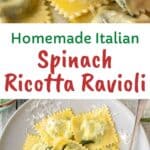
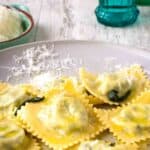
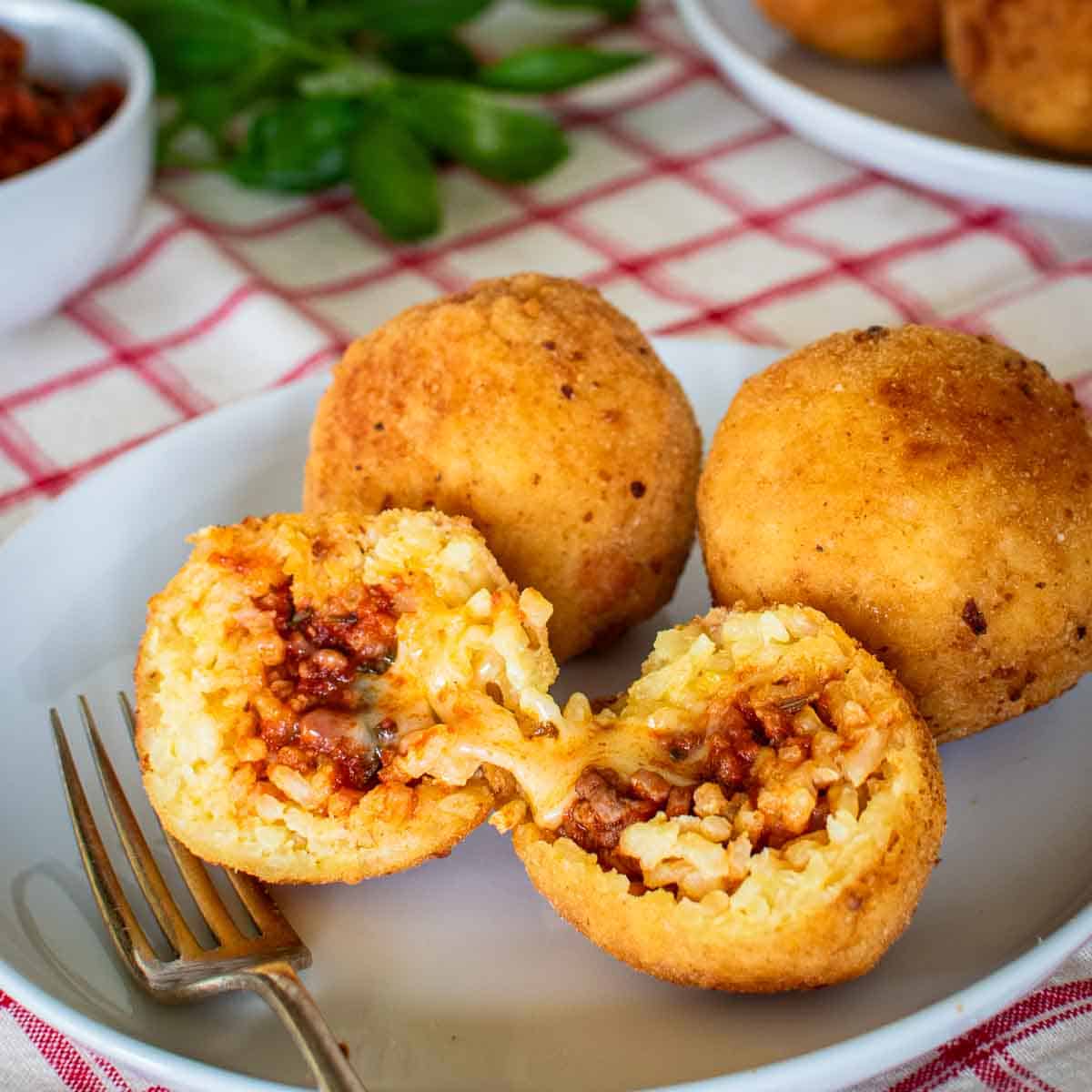
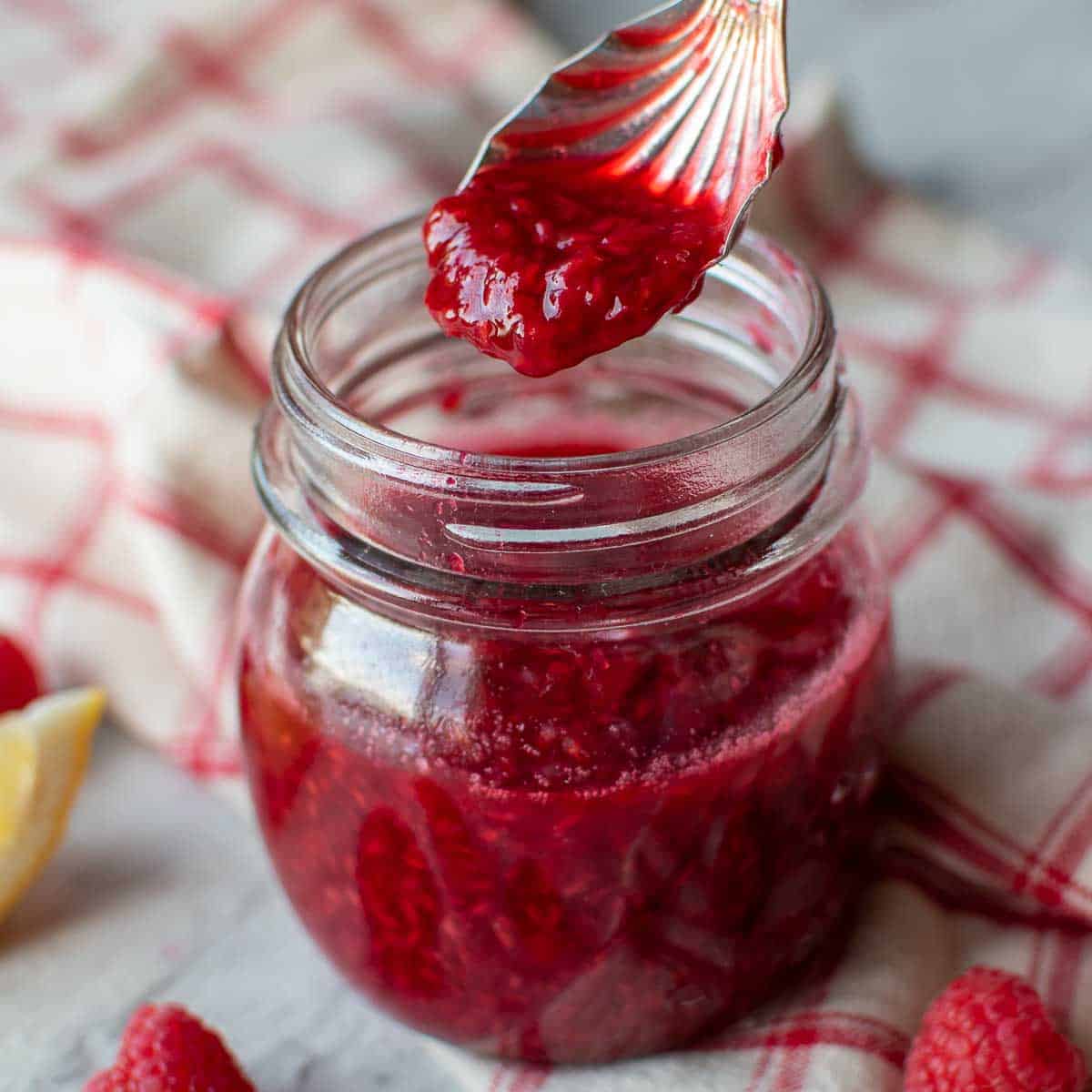
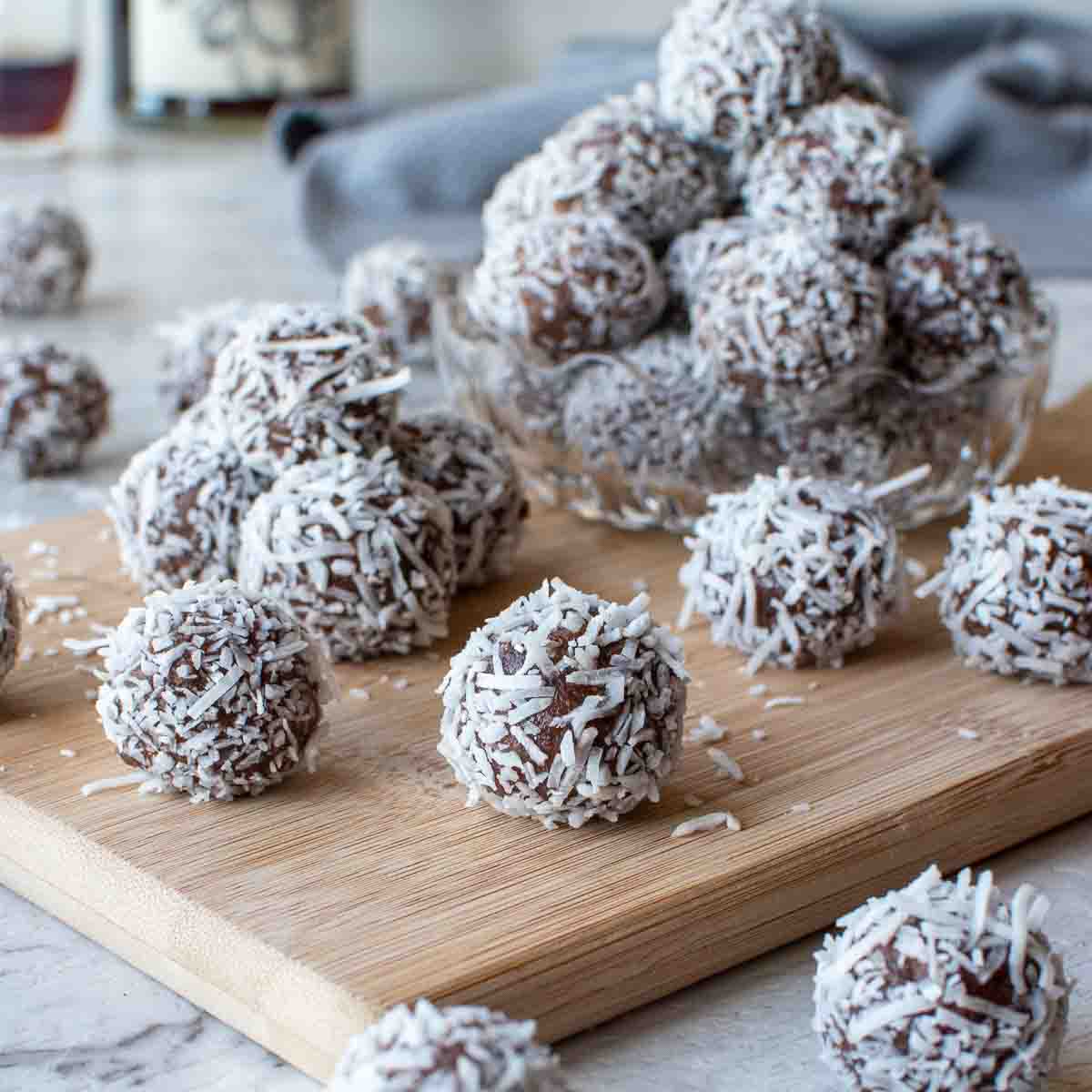


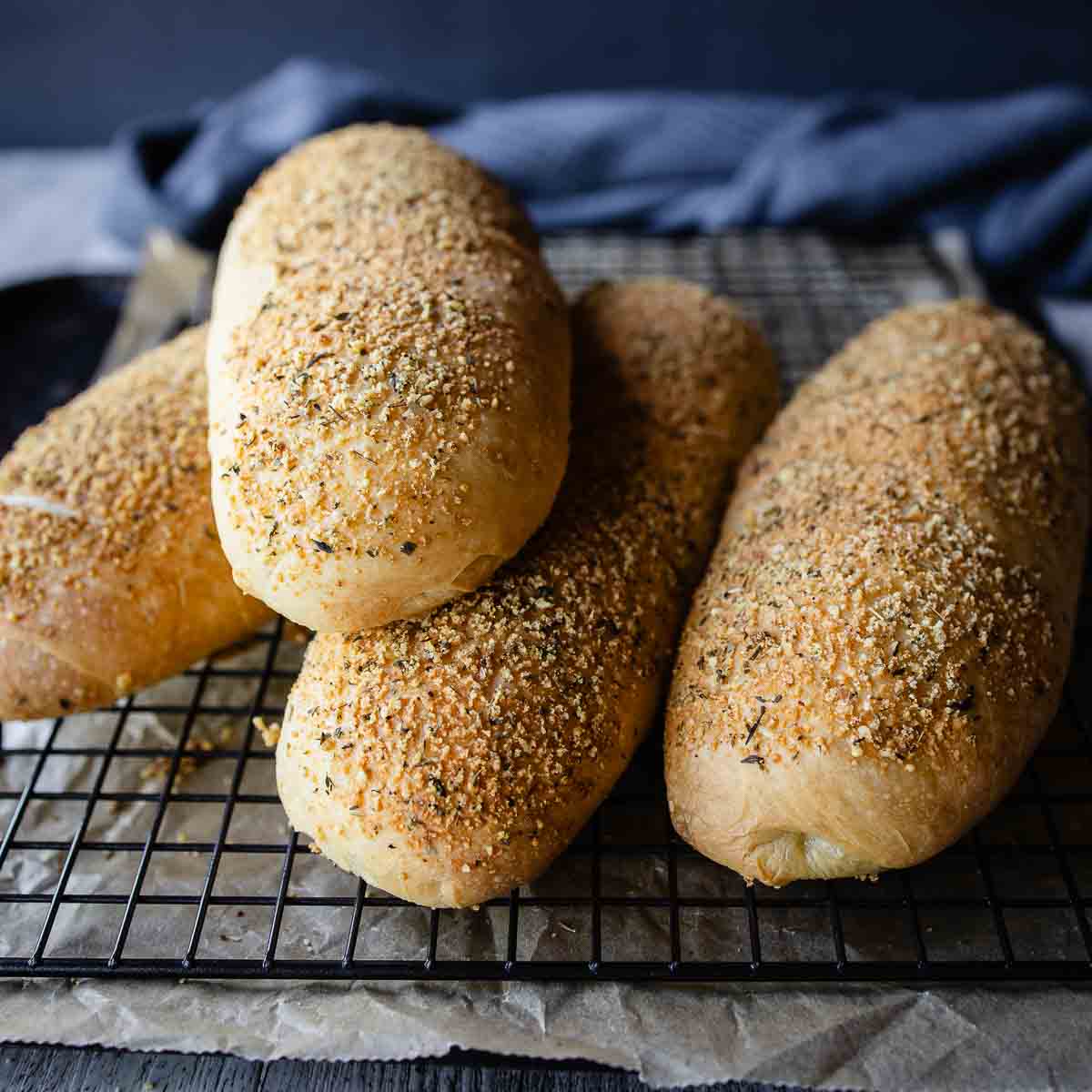
will it reheat in a microwave. I want to make it for a shared lunch at work.
Alison, it will but it won’t be at it’s best. Do you have a stove at work to cook the ravioli and then combine them freshly with the sauce and cheese?
My first time making ravioli of any kind. The filling was perfect! I learned a lot about techniques. I used excess filling to make a sauce with butter, cream and chicken bouillon.
Thank you for your comment. I happy you loved this Spinach Ricotta Ravioli recipe.
Great recipe – I also added garlic to the butter sauce & loved it!
Oooh yes, we often do too!
The best ravioli ever!!!
I’m glad that you loved them as much as we do!
4 ounces finely grated Parmigiano Reggiano (120 grams) seems like a lot combined with the 1 pound of ricotta cheese. In the past when making regular cheese ravioli I never used that much parmigiana. Is this quantity correct? Just want to make sure before I start combining these ingredients.
Yes, that’s my recipe. Of course, if you’d rather use less, that’s fine. It won’t be a problem. The important thing if that if you’re using that much Parmigiano Reggiano cheese it must be very good quality.
Just tried it for dinner and turned out perfect!
I’m happy that you loved making and eating these homemade ravioli, Antonia!
This is a brilliant recipe I absolutely adore it will def be making this all the time thank you ever so much Marcellina!!
Holly, this is exactly why I love sharing my recipes. Being able to inspire you to make this delicious recipe is exactly what I aim to do. Thank you for your wonderful feedback!
I made this tonight for the pasta course of my family’s New Year’s Day dinner. It was spectacular and got 10/10 from everyone! The simple brown butter sauce was so flavourful and the ricotta-spinach filling was so delicious. I’ve already been asked to make it again! Worth the time and effort. I made the brown butter sauce and the ricotta-spinach filling last night to save some time today since I was making several courses. It was a smart move. Thanks for this delicious recipe!
I’m thrilled with your wonderful feedback, Susan and so happy that everyone appreciated your efforts!
this has really persuaded me to make this! THANK YOU SUSAN
I made the ravioli tonight and am freezing for New Years. I got about 24 out of this but I still had dough and made fetticine, and I’ll figure out what to do with the extra cheese mixture. Recipe worked great! Thanks.
I’m glad you were happy with the recipe. Funny coincidence, I’m making these for New Years too!
Terrific recipe!! Made it for Christmas dinner to go with our turkey – followed the recipe, except I used King Arthur AP flour – will definitely make again! It was such a hit!
Hi Marcellina. So glad I found your site. I don’t have broadband but can access you from my phone. I made ricotta yesterday then made ricotta and spinach raviolis. First time making ricotta and it’s beautiful. Had enough left to sweeten with honey and have it on toast with choc hazelnut sprinkles – I whizzed up a bar of hazelnut choc. I’m not a ‘techy’ person but I recognise that you have an excellent set-up and I look forward to making many more of your inspirational recipes. Thank you so much.
I’m so happy to hear that, Sue! Homemade ricotta is amazing!
The dough was very dry when made as per recipe. Had to throw it out and found a better recipe.
Hello Punky. I suspect that you have incorrectly measured the flour. Weighing is the best method however if you are using measuring cups be sure to stir the flour then spoon into the cups without packing the flour. My family pasta dough recipe is very similar to all other recipes for pasta dough (1 egg per 100 grams of flour). Pasta dough is incredibly forgiving and you should never have to throw it out (what a waste!). Too dry? Add a little water. Too wet? Add a little flour. Luckily pasta dough isn’t a science. Nonnas in Italy have been making it for years without measuring. However I understand that if you’ve never made pasta dough you would need a recipe. Saying that, if you had made it as specified in the recipe, you would have gradually been incorporating the flour in so you know when enough flour has been incorporated. It is possible that the area you live in is extremely dry. Pasta dough is a wonderful creation that is guided and is in rhythm with the environment, the humidity and the warmth of your hands.